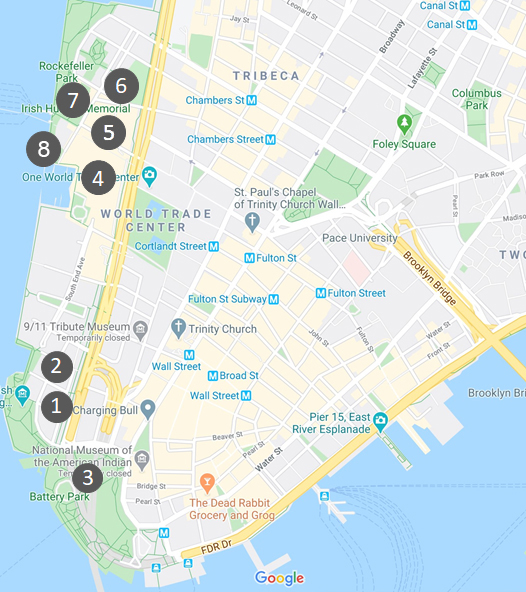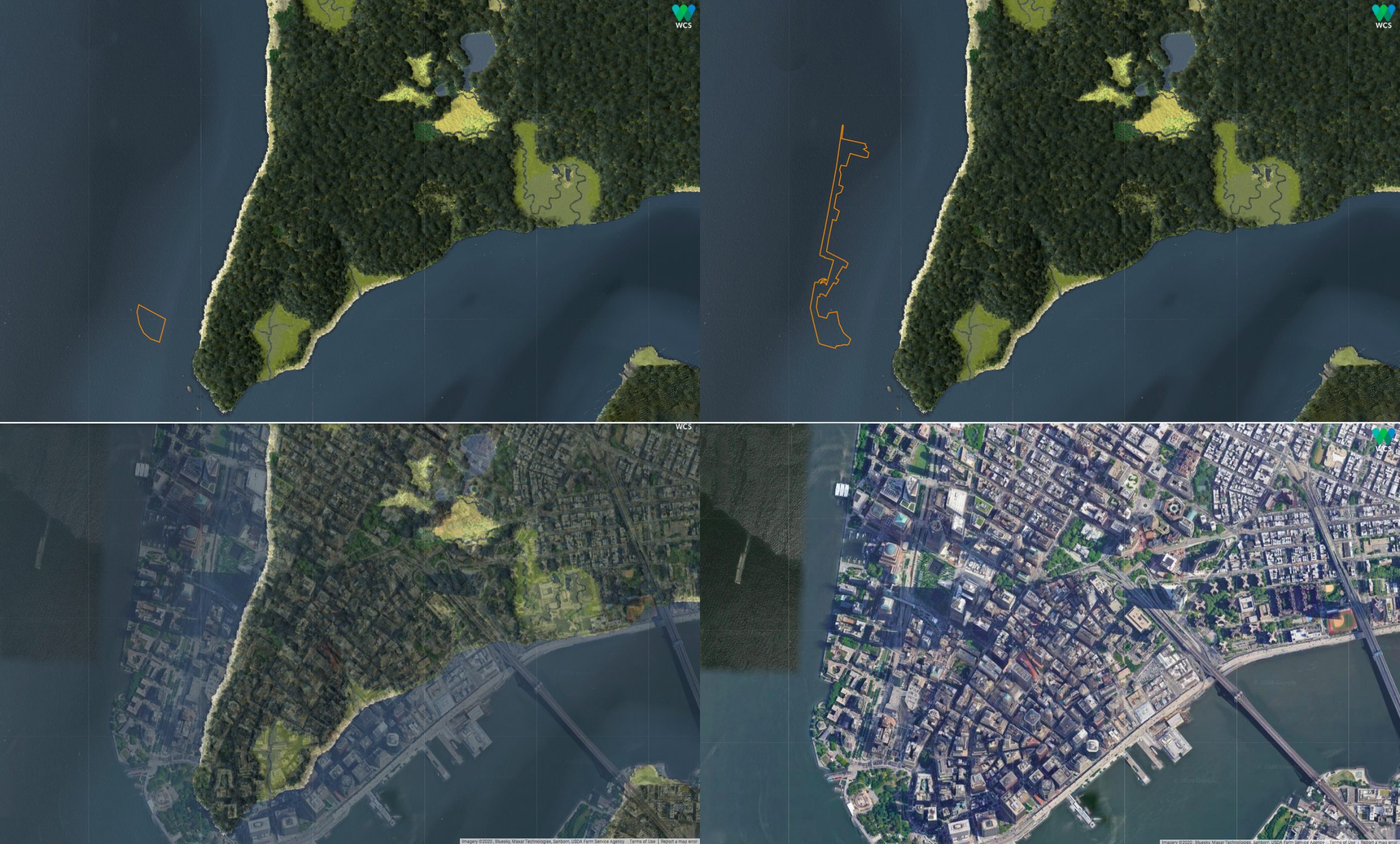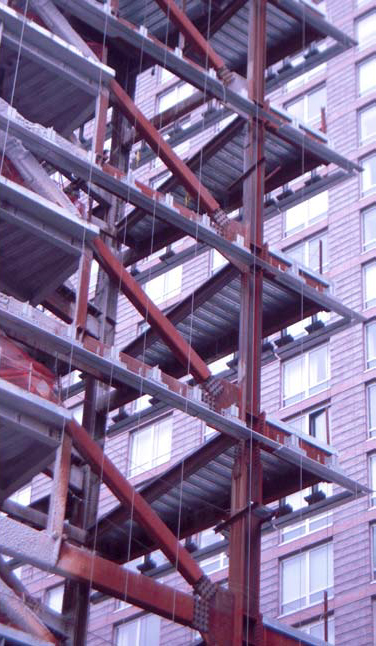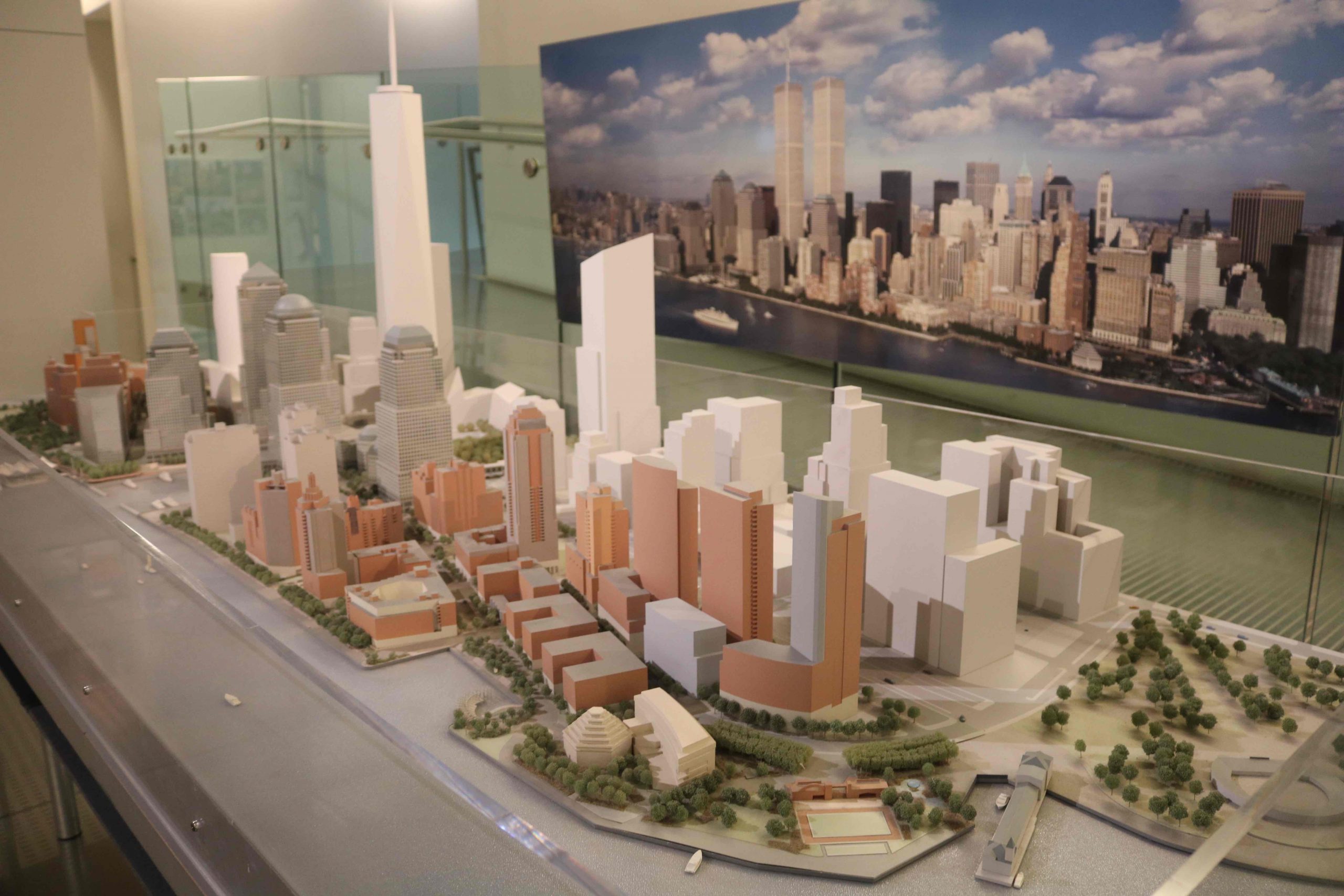Battery Park City Virtual Walk Itinerary

Itinerary: You’ll start at The Skyscraper Museum.
- Skyscraper Museum, 39 Battery Place
- Battery Park City School, 55 Battery Place
- Robert Wagner Park and Pavilion, 20 Battery Place
- World Financial Center/Brookfield Place, 230 Vesey Street
- The Verdesian, 211 North End Avenue
- Tribeca Green, 325 North End Avenue
- Solaire, 20 River Terrace
- One River Terrace, 1 River Terrace New York
Let’s meet at Battery Place and First Place!
Battery Park City Virtual Tour
Battery Park City is one of the many landfill extensions that redefined Manhattan’s shoreline. Michael Kimmelman’s New York Times article, “When Manhattan Was Mannahatta: A Stroll Through History” looks at the island’s transformation from a swath of lush forestry and freshwater basins to the world-class city we know today, based on Eric W. Sanderson’s 2009 book Mannahatta: A Natural History of New York City. According to Sanderson’s account, the west side of the island was once a strip of white sand beach stretching from Lower Manhattan to 42nd Street and later rebuilt to expand the reaches of the borough; to learn more about the Manhattan’s geographic history, the Welikia Project provides a map-based interface that envisions the physical evolution of the island. Battery Park City sought to reintroduce the terrain that once characterized the island as a central design element for livable and environmentally responsive spaces for the city’s growing population.

Top left: the current location of The Skyscraper Museum. Top right: Outline of the waterfront esplanade in Battery Park City. Bottom left: modern day Manhattan superimposed on original landmass. Bottom right: Manhattan as it appears today.
Source: Welikia
Battery Park City Authority introduced the Residential Environmental Guidelines in 2000 followed by the Commercial/Institutional Environmental Guidelines in 2002, setting environmental design guidelines that led to the construction of many buildings ahead of the current standards. The Battery City Park School is one building constructed under these codes. To adapt to the evolving times of climate resiliency, the agency passed a 10-Year Sustainability Plan on April 22, 2020, outlining the community’s capital improvements and programs goals towards a sustainable future. The agenda is broken down into four sections -- energy, water, waste and site actions -- detailed from page 34 to 98. As a result of these cumulative efforts, Battery Park City is famously known as one of the first “green communities” and a model for urban development.
With our virtual green tour, you can explore the neighborhood from home through Google Earth and plan your future visit.
Do you know which way is north? If yes, face that way! You should see an orange and tan building with a needle pointing upwards.
Now, look to your right and you will see the Skyscraper Museum. This is the first stop of our tour. 39 Battery Place became the museum’s permanent location in Battery Park City in March 2004. The museum shares the building with The Wagner Hotel in Battery Park City.
The next stop on our virtual tour is right across the street at the Battery Park City School north of the museum.
Do you notice any colors on the outside of the building? If you answered orange red, you are correct. The outside of the school is made of bricks placed on top of each other in a pattern.
Although the building looks very long, it is actually on top of a small city block!
Do you know what makes the building stand up? It has pieces of steel and concrete that make up its skeleton! It is like the human skeleton, our bones, that make us stand. But steel and concrete take a lot of power to make. Remember we said buildings in Battery Park City have to follow a green code? To make sure we don’t waste power making these materials, the school is made of 10% recycled matter.


The steel skeleton of the Battery Park School provides a very strong frame made up of hundreds of steel pieces. If you look at the picture on the far left, you can see what this frame looks like before walls and floors are built on around them. For high-rise buildings, steel-frame construction is quick to erect, uses less resources, and allows more of the walls to be open for windows to bring as much sunlight inside as possible. If you want to know more, check out our Green School Lesson Plan here!

Model of early design for Wagner Park and Pavilion, 1993. Machado Silvetti, collection of Battery Park City Authority.
From the school, we will walk south along Battery Place to Robert F. Wagner Jr. Park.
Located southwest across from the Skyscraper Museum, Robert F. Wagner Jr. Park is a public park by the water with beautiful views of the Statue of Liberty and New York Harbor. The space has two pavilions connected by a wood bridge surrounded by fields of grass. The pavilions are made of the similar type of brick and pattern as the Battery Park City School we just visited!
The model and framed drawing and in the case to the left are early schemes for the Robert F. Wagner Jr. Park and Pavilion, designed by the Boston-based firm Machado Silvetti. The park, directly across the street from The Skyscraper Museum, opened in 1996. The ensemble of architecture and landscape design, by Hanna/Olin and garden designer Lynden B. Miller, features a grassy plane sloping down to the harbor and framed by two brick pavilions joined by a wooden bridge.
See the exhibition MILLENNIUM with these models and more!

We'll walk north along Hudson River Greenway and head down to our next destination, Brookfield Place. It's a beautiful ten-minute stroll along the river until you come to the marina. Look across the marina and the plaza and up, and you will see the top of One World Trade Center and it's spire that stretches to 1,776 feet! Across the marina and you will see four skyscrapers surrounding you, all with similar shapes, colors, and materials and a lower glass building with a high vault, the Winter Garden.
Brookfield Place, completed in 1986 and previously known as World Financial Center, is a 14-acre complex designed by the renowned firm Pelli Clarke Pelli Architects that consists of four office buildings of 34 to 51 floors, the central vaulted glass atrium surrounded by stores, and a large public plaza. The two towers leading to the court’s entrance and waterfront have interesting octagon-shaped floor plans. These buildings, called Postmodern in their style, originally contrasted with the extreme height of the shiny, straight-up Twin Towers. Their stepped-up rectangular forms with rounded domes and pyramid-inspired tops relate to the setback skyscrapers of the 1920s and 1930s.
On colder days, it is nice to sit on the court’s grand staircase with the view of the rows of giant Arizona palm trees. During the summer, the plaza is a great place to relax, with different spots to take pictures and eat, especially during sunset. There are art installations, concerts, and various events that are great to explore. This spot is a fun spot for everyone! Let’s take some time to explore the site!
Alright, we stayed long enough. We will continue to our next destination, The Verdesian. To get there, we will walk north along West Street to Murray Street and west to North End Avenue. When you reach the intersection, the building on your left should be your destination.
Like Brookfield Place, the Verdesian is designed by Pelli Clarke Pelli Architects! It was completed in 2006. The 24-story high-rise has 253 apartments and a total of 253,000 sq. ft. of space! The design is inspired from Lower Manhattan’s architecture, with red brick and window patterns found in Tribeca and Soho, and newer glass buildings all around downtown for a modern look. It is the first apartment building to get a Platinum LEED rating. The building uses many energy efficient technologies such as air-filtering, construction material recycling, and water recycling!
Now, we will head to the next location on the tour, Tribeca Green. You can walk one block to Warren Street. The building on the southwest corner is the spot!
Looking at the building, do you notice any familiar colors we saw before? If you answered, red brick from the Battery Park City School and The Verdesian, you are correct. Many buildings in the area have this material on their outer walls. Tribeca Green stands 230 feet tall with 357,000 sq. ft of space. Like previous buildings, this one has 274 apartments. The architect Robert A.M. Stern planned the building. One interesting fact: the developer, Related Companies, is the same as that of the Hudson Yards in Midtown Manhattan!
And yes, you guessed right, this building also has LEED status—Gold ranking. The structure uses many sustainable practices to lower utility bills such that its green roof helps stop water runoff and reuses it in the building’s system!
We will have some fun and move on towards the waterfront. Yes, I know you have been waiting. We will head to The Solaire. It is one street south from the corner of Warren Street and River Terrace.
Like the previous two, this building also has a two level structure that looks like two stacked boxes. Similar to The Verdesian and Brookfield Place, Pelli Clarke Pelli Architects created the design for this tower. The building has 294 apartments at 283 feet tall. The Solaire is also in the competition for sustainability, with impressive titles! It was awarded the AIA Top Green Project in 2004, the first residential building to get LEED Gold ranking, selected site by the U.S. Department of Energy in the Green Building Challenge, as well as the earliest to receive funding from the New York State Green Building Tax Credit! Some sustainable practices used at the location include reusing water, filtering air, controlling indoor lighting and climate, installing ozone free and natural gas appliances, and recycling construction materials.
This apartment building was completed in 2007. How tall do you think the building is? It looks very tall looking up, but it is only 312 feet tall. What else can you observe about the design of the building? It looks like two rectangle boxes stacked on top of each other, one curved laying flat and the other standing up. If you want to live here, there are 264 units you can choose from. Like many of the sites on this tour, the structure also has LEED gold status, employing many of the technologies mentioned in the previous buildings. It is a very green building even if it doesn’t look green!
We have come to the end of this virtual tour. Hope you enjoyed and learned something today!
Activity 3: Design Your Own Green Neighborhood
As we saw in the time lapse maps at the beginning of Activity 2, the tip of Manhattan has been greatly expanded over time.

Materials needed:
- paper (or print out a helpful map)
- markers/colored pencils
- printer (optional)
Imagine that NYC is planning on building a new neighborhood today, similar to how BPC was built in the late 1960s—by expanding the island out into the water.
Think about how you would to add this new neighborhood and why. Would you extend your favorite neighborhood or be a whole new one? What would its shape be and why? Would it be primarily residential, a new business district, a park, or serve a different function? Would you build it to match its surroundings or create a new "natural" waterfront like Battery Park City? There are many questions to consider. Go ahead and give your neighborhood a name—you can even name it after yourself!
Click here to find a downloadable map to print out or trace from.
Your new neighborhood should be built with sustainability in mind, from its street layout to the individual buildings. Draw some streets in your neighborhood, and don’t forget to add parks and open spaces for people that live and work there to enjoy. Take as much time as you want, and don’t forget to look at other NYC neighborhoods to give you ideas. Many architects and developers draw inspiration from other buildings and neighborhoods so feel free to do the same!
Now, think back to all the things you learned about sustainable buildings on the Battery Park City Virtual Tour. What were some of the most interesting green building ideas you learned about? How would these look on buildings in your new neighborhood? Think about whether you would match the materials and design of buildings as seen in the red brick of buildings in Battery Park City. Make your design exciting and sustainable!

